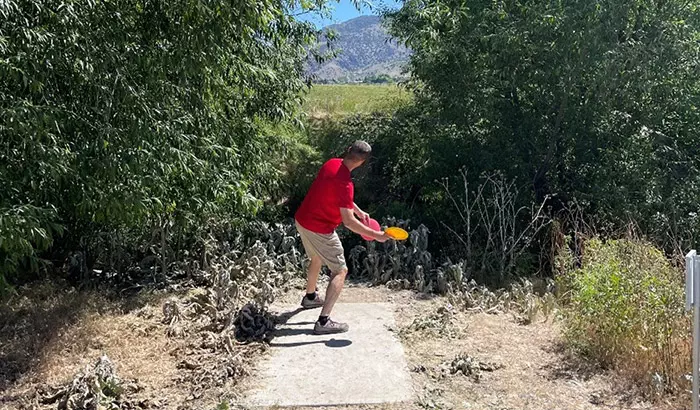Last updated on January 29th, 2024 at 04:08 pm
Last updated by Simon
If your buddy tells you that he needs to get a driver who is a little more stable, do you know what he means in the context of Overstable vs Understable Discs? The truth is, it depends on the context. If someone is throwing a flippy disc like an I-Blend Sphinx and wants something more overstable, they seek greater stability. Conversely, if they’re using an overstable disc like a Concrete Slab and desire something more stable, they likely seek a less overstable disc. The current terminology doesn’t always provide a clear indication of stability preferences.
Many of us are familiar with the four-number flight rating system in our sport, indicating the disc’s speed, glide, and lateral movement at various speeds. Nevertheless, these numbers have limitations and are typically just general guidelines.
Overstable vs Understable Discs
This blog post will address the meaning of overstable vs understable flights. I will give examples of discs that are known for their stability. I will also discuss when those discs could be used during a round of disc golf.
When discussing disc stability, including its overstableness, we think about its resistance to turning right during a Right Hand Back Hand (RHBH) throw at high speeds and its strong leftward fade as it slows down.
Disc Golf Physics

What makes a disc over- or understable? Without delving into the theoretical and scientific aspects of disc golf flight, let me provide some unscientific but practical insights into how aerodynamics affect real-world disc flight.
When a disc is thrown, it reaches its highest speed initially and continues to slow down during its flight. In this high-speed phase, the forces on the disc strongly influence it to turn right, primarily due to rotational forces and the impact of high speeds on the disc rim shape. The degree of turn depends on the throw’s speed (excluding environmental factors) and the disc’s design.
As the disc slows down, the forces that initially made it turn right are overcome by the forces causing it to turn left, resulting in a leftward fade until it lands. This simplified explanation suffices for our purposes. While the physics of disc flight is academically interesting, it’s not necessary for disc selection. We only need to understand that certain discs exhibit specific flight characteristics.
Overstable Discs: What and When

As mentioned earlier, overstable discs resist turning right at high speeds and fade left earlier than less overstable ones. This knowledge helps us select appropriate shots for specific situations. When using the four-number flight system, overstable discs typically have a high fade and a small turn number (often 1, 0, or -1). Here are some examples of when we might reach for an overstable disc:
Headwind – Overstable discs are ideal for throwing into a headwind because they resist turning at high speeds. Despite a headwind causing slight turn, a suitably overstable disc will still provide the straight shot you want. Throwing the wrong disc into a headwind becomes evident when it sharply turns right and descends abruptly.
Flex shot – A flex shot intentionally starts on an anhyzer angle, forcing a right turn before the disc stabilizes and finishes to the left. With an overstable disc, you are confident the disc WILL end up fading left.
Downhill shot – When throwing downhill, the disc remains in the high-speed phase for an extended period, often requiring no turn. Overstable discs, as mentioned, resist turning and are more likely to provide the straight shot you desire.
Straight, with a hard left finish – When you are looking for a straight shot with a hard left finish, you are pretty much using an overstable disc for what it was made for. A flat, level flight with a solid fade at the end is the definition of an overstable disc.
Forehand (flick) shot – Although not essential, many favor more overstable discs for flick shots due to their ability to handle increased torque and speed, reducing worries about the disc turning right upon release.
Similar to the forehand shot, you can throw the overhand shot (thumber or tomahawk) with an overstable disc to achieve faster rotation and a narrower overall shot.
Understable Discs: What and When

An understable disc flies with the opposite characteristics than an overstable disc. It has a tendency to turn to the right while the disc is at its highest speed. How much it turns depends on the third number in the four-number flight rating system. Typically, understable discs have a turn rating of -2, -3, or -4. The fade is usually smaller than overstable discs. Here are examples of when someone might throw an understable disc.
Tailwind – Since a tailwind decreases the amount of air flowing around the disc, a disc becomes more overstable. That makes an understable disc easier to throw. Overstable discs would just make a hard left turn, but an understable disc can still have a long flight.
Late turn to the right – Thrown with slight hyzer, an understable disc can transition into an anhyzer angle, producing a rightward turn later in the flight. This technique can be valuable if you lack an effective forehand shot.
Roller – While not obligatory, using an understable disc for a roller shot simplifies achieving the required angle. Overstable discs can be coerced into roller shots, but an understable disc allows for a more extended air shot before it transitions into a roller. This type of roller can yield some of the longest distances achievable.
Uphill shot – Since an uphill throw uses more energy to gain in elevation, the disc will slow down faster and start to fade earlier. Throwing an understable disc gives the disc a longer flight before it starts to fade.
Giant s-curve –
For maximum distance, throw an understable disc on a hyzer angle with a slight upward aim, allowing it to gradually roll over, ascend, stabilize, and fade left. This flight path, commonly used for distance records, sacrifices accuracy for greater distance coverage.
Headwind vs Tailwind – I’ve heard numerous people ask if they should throw an understable or an overstable disc in a headwind/tailwind. The easiest way to remember which is which, is to think about the throw from the perspective of the disc. If you throw the disc at 60 mph into a 20 mph headwind, from the disc’s perspective, it’s traveling at 80 mph. An overstable disc will fight the extra speed better than an understable disc. An understable disc will turn even more than usual in a headwind.
Conversely, a tailwind in the above scenario would mean your effective speed of the disc would be 40 mph. At that speed, an overstable disc fades quickly, while an understable disc remains stable, making it the preferred choice in a tailwind.
Mold Examples
Examples of overstable vs understable discs
Some examples of overstable discs include:
Concrete Slab (12, 3, 0, 4)
Scepter (9, 4, 0, 4)

Some examples of understable discs include:
Maya (12, 5, -3, 1)
Sphinx (9, 6, -3, 1)
Kon Tiki (4, 5, -3, 0)

Having discs with various stabilities is like having a range of tools in our toolbox. Given the different scenarios we encounter on the course, having confidence in our disc options is essential. It’s ideal to have the right tool for the job.

